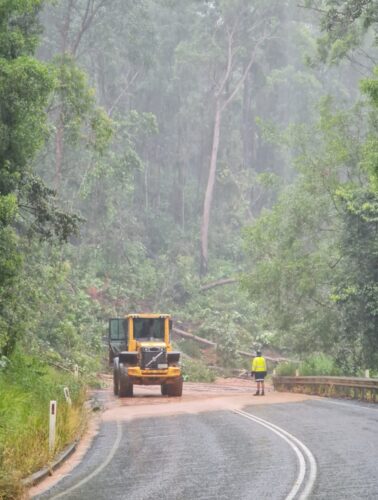Landslips
Landslips can occur after rain or fires due to a weakening of the earth, especially in areas where vegetation loss has occurred due to fires or floods. According to the Australian Geomechanics Society,
“It is important to realise that even a 1 cubic metre boulder of soil, or rock, weighs at least 2 tonnes. If it falls, or slides, it is large enough to kill a person, crush a car, or cause serious structural damage to a house”.
Areas that are prone to landslips include
- Existing old landslides.
- On or at the base of slopes.
- In or at the base of minor drainage hollows.
- At the base or top of an old fill slope.
- At the base or top of a steep cut slope.
Use the tabs below to get prepared Before, During and After an event.
Before a Landslip
Step 1: Know your Risk
- Check with Council and neighbours for the area’s history of landslip or instability.
- Be aware of structures such as decks and patios tilting and/or moving relative to the main house.
- Watch for tilting or cracking of concrete floors and foundations.
- Watch for broken water lines and other underground utilities.
- Keep a look out for leaning telephone poles, trees, retaining walls or fences.
- Be aware of sunken or down-dropped road beds.
- Observe the patterns of storm-water drainage near your home, and note the places where runoff water converges, increasing flow in channels.
These are areas to avoid during a storm. - Consider planting ground cover on slopes and build retaining walls.
Step 2: Plan
- Know your risk
- Know where to go
- Know who to call
Join your neighbourhood hub & get to know your neighbours
If you are already not part of your Neighbourhood Group, find and connect with your local leader if you are in Uki or Greater Uki.
Get to know your neighbours.
Step 3: Prepare
- Get your emergency kit together
- Make your home emergency plan that includes your pets
(see Prepare Your Household for more on this) - Ensure each family member knows how to get back in touch if you are separated during an emergency
During a Landslip
- Stay alert and awake. Consider leaving if it is safe to do so. Be prepared to evacuate immediately.
- Be alert for unusual sounds that might indicate moving debris such as trees cracking or boulders knocking together.
Be aware that heavy, short bursts of rain may be especially dangerous after longer periods of heavy rainfall and damp weather.
If you are in areas susceptible to landslips, consider leaving if it is safe to do so.
Remember that driving during a heavy storm can be hazardous.
If you remain at home, move to a second story if possible. - If you are near a stream or channel, notice whether the water changes from clear to muddy. This could mean that there is debris flow activity upstream so be prepared to move quickly.
- If you are driving, watch for collapsed pavement and roads, mud, fallen rocks and other debris.
- Consider evacuating large animals as a precaution as soon as you are aware of impending danger.
- If indoors, move to the least-affected end of the building under a strong table or bench (if possible use a mattress for extra protection). Hold on firmly until all land movement has ceased.
- If outdoors and you are in the path of a landslip, move quickly from its path and keep clear of banks, trees, power lines and pole.
- Never walk across a landslip.
If you suspect imminent danger, evacuate immediately and take your animals with you.
Inform your neighbours, if you can, of your location.
Follow your emergency plan.
After a Landslip
- Call Triple Zero (000) to report a landslip emergency.
Contact SES if you require help. - Notify your neighbours of your location. Let your neighbourhood group know in case the landslip is causing obstructions or other hazards.
- Avoid the slip area in case of danger of additional slips. Watch for fallen powerlines and take additional care if you are using a chainsaw on fallen trees.
- If able to, check for injured and trapped persons near the slide, without entering the direct slide area. Direct rescuers to their locations.
- If possible, help a neighbor who may require special assistance–infants, elderly people, and people with disabilities.
- Look for and report broken utility lines to appropriate authorities. Reporting potential hazards will get the utilities turned off as quickly as possible, preventing further danger and injury.
- Check the building foundation, chimney, and surrounding land for damage to assess your ongoing safety in the area.
- Seek the advice of a professional if you think structural damage to your property has occurred.

Stay informed and go to the useful Apps, Numbers & Links page to download relevant apps and bookmark links.
CALL 000 to report a Landslip
For help phone SES on 132 500
Call essential energy on 132 080 for
Loss of Power or fallen Powerlines